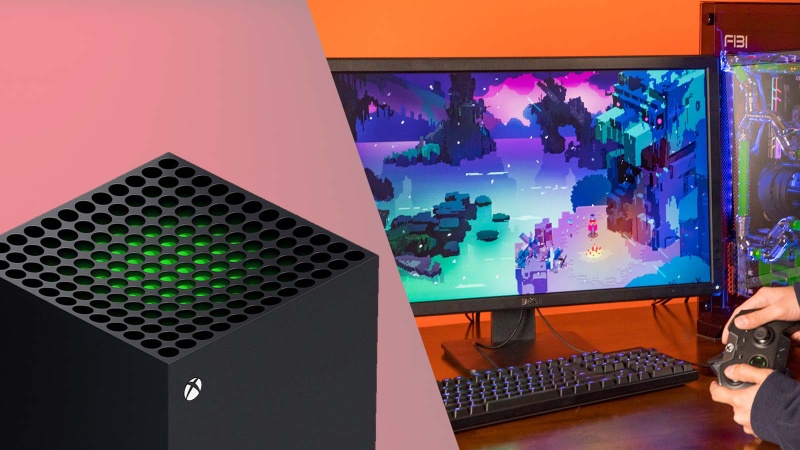1. Introduction: The Console vs. PC Performance Question
The Xbox Series X and Series S have become incredibly popular choices for gamers seeking next-generation experiences at different price points. As these consoles continue to dominate the living room, many PC enthusiasts and developers find themselves asking a common question: what GPU is equivalent to Xbox Series X performance? Understanding these equivalents helps PC builders create systems that match or exceed console gaming experiences while also providing valuable insights into the different tiers of graphics processing power available in the market.
This guide will identify the closest Xbox Series X GPU equivalent and Xbox Series S GPU equivalent from current AMD and NVIDIA lineups, breaking down the technical specifications that make these comparisons valid. More importantly, we’ll explore how these consumer-focused gaming GPUs represent just one segment of the graphics processing spectrum – and why the computational demands of artificial intelligence require a fundamentally different approach, one that professional solutions like WhaleFlux are specifically designed to address for enterprise applications.
2. Xbox Series X GPU Equivalent: Matching a Console Powerhouse
The Xbox Series X stands as Microsoft’s flagship console, featuring impressive graphics capabilities that target 4K gaming at 60fps, with support for up to 120fps in certain titles. To understand what makes a suitable Xbox Series X equivalent GPU, we need to examine its technical foundation.
The Series X features a custom AMD RDNA 2 architecture GPU with 52 compute units running at 1.825 GHz, delivering approximately 12 teraflops (TFLOPS) of processing power. It includes 16GB of GDDR6 memory with a 320-bit bus, providing 10GB of optimized memory for gaming at 560GB/s bandwidth. When comparing these specifications to PC graphics cards, the closest Xbox Series X GPU equivalent in terms of raw computational power and architecture becomes the AMD Radeon RX 6700 XT or NVIDIA’s RTX 3070.
However, it’s important to contextualize that real-world performance can vary significantly due to console optimization. Console games are specifically tuned for fixed hardware configurations, allowing developers to extract maximum performance. This means that while an Xbox Series X equivalent GPU on PC might have similar theoretical performance, the actual gaming experience may differ based on game optimization, driver maturity, and system configuration. Nevertheless, these PC graphics cards provide a comparable gaming experience at similar resolution and frame rate targets.
3. Xbox Series S GPU Equivalent: The Budget-Friendly Option
Microsoft’s Xbox Series S serves as an affordable entry point into next-generation gaming, designed primarily for 1440p gaming at 60fps (with support for 120fps). Understanding the Xbox Series S GPU equivalent helps budget-conscious gamers make informed decisions about PC building or upgrading.
The Series S features a scaled-down version of the RDNA 2 architecture with 20 compute units running at 1.565 GHz, delivering approximately 4 TFLOPS of processing power. It includes 10GB of GDDR6 memory with a 128-bit bus, providing 8GB of optimized memory at 224GB/s bandwidth. The closest Xbox Series S GPU equivalent in the current PC market would be the AMD Radeon RX 6500 XT or NVIDIA’s GTX 1660 Super.
The Series S represents an exceptional value proposition for console gaming, but its PC equivalents face different market conditions. While the console benefits from the same optimization advantages as its bigger brother, the PC GPU equivalent cards must operate in a more variable environment. Still, for gamers primarily interested in 1080p to 1440p gaming, these equivalent graphics cards deliver similar performance profiles when paired with appropriate supporting hardware.
4. The Bigger Picture: Beyond Gaming Performance
While finding console equivalent GPU options is valuable for gamers, it’s important to recognize that these comparisons primarily address just one application of graphics processing technology: gaming. The consumer GPU market represented by these equivalents focuses predominantly on rendering graphics efficiently and effectively for entertainment purposes.
This stands in stark contrast to the requirements of artificial intelligence and computational workloads. While gaming GPUs are optimized for sequential rendering tasks, AI computation demands massive parallel processing capabilities. The architecture that makes a graphics card excellent for gaming doesn’t necessarily translate to optimal performance for machine learning, data science, or large language model training.
This performance gap becomes particularly evident when examining the specialized hardware features required for serious AI work. While an Xbox Series X equivalent GPU might excel at rendering complex game environments, it lacks the specialized tensor cores, larger memory configurations, and computational precision required for enterprise AI applications. This distinction highlights how GPU technology serves vastly different markets with different priorities and requirements.
5. When You Need More Than a Gaming GPU: The AI Challenge
The scale of computational power required for artificial intelligence workloads, particularly for training large language models, dwarfs what’s needed for even the most demanding games. While a high-end gaming GPU might struggle with AI tasks that take days to complete, enterprise AI applications often require multiple specialized GPUs working in concert for weeks or months at a time.
The hardware requirements for serious AI work extend far beyond what consumer graphics cards can provide. Training sophisticated models requires not just raw computational power, but also massive memory bandwidth, error-correcting code memory, and specialized processing cores designed specifically for matrix operations and neural network calculations. Consumer cards like those that serve as console equivalent GPU options hit immediate walls when faced with these demands, primarily due to memory limitations and architectural constraints not designed for computational workloads.
This creates a significant challenge for businesses and researchers looking to leverage AI technology. The hardware investment required extends far beyond what’s needed for gaming, and the complexity of managing multiple high-end GPUs introduces operational challenges that require specialized expertise and infrastructure.
6. The Enterprise Solution: Scalable GPU Power with WhaleFlux
For businesses tackling AI challenges, the question shifts from “what is the Xbox Series X GPU equivalent?” to “how can we access scalable, managed computational power that meets our specific needs?” This fundamental rethinking of resource acquisition is where WhaleFlux provides a transformative advantage over consumer-grade solutions.
WhaleFlux is an intelligent GPU resource management platform specifically designed for AI enterprises facing the challenges of scale and complexity. While consumer graphics cards serve individual users for gaming and content creation, WhaleFlux operates at the infrastructure level, optimizing clusters of high-end GPUs for maximum efficiency and stability in training and deploying large AI models. The platform represents a paradigm shift from thinking about GPUs as individual components to treating computational power as a managed service.
7. Why WhaleFlux is the Next Step for Computational Needs
The transition from consumer-grade to enterprise-level computational resources involves several critical advantages that WhaleFlux delivers through its specialized approach to GPU management.
Access to Superior Hardware
While an Xbox Series X equivalent GPU serves gamers well, WhaleFlux provides access to professional-grade GPUs specifically engineered for computational throughput rather than graphical rendering. This includes the NVIDIA H100 and H200 with their transformative transformer engine technology, the established workhorse NVIDIA A100, and the powerful NVIDIA RTX 4090 for cost-effective inference tasks. These processors feature architectural optimizations, massive memory configurations, and specialized cores that consumer cards simply cannot match for AI workloads.
Managed Clusters, Not Single Cards
WhaleFlux eliminates the complexity of building and maintaining powerful AI workstations or servers by providing managed multi-GPU environments. The platform handles the intricate tasks of load balancing, inter-GPU communication, health monitoring, and optimization that would otherwise require significant expertise and administrative overhead. This allows AI teams to focus on model development rather than infrastructure management.
Cost-Effective Scaling
Through flexible purchase or rental models with monthly minimum commitments, WhaleFluxprovides a strategic approach to accessing top-tier AI hardware without massive upfront capital investment. This model aligns with the sustained development cycles typical of AI projects, offering predictable pricing and resource availability that contrasts with the volatility of consumer hardware markets and the complex pricing of hourly cloud services.
Conclusion: Choosing the Right Tool for the Task
Understanding GPU equivalents helps bridge the gap between console and PC gaming performance, with the Xbox Series X equivalent GPU roughly matching an RX 6700 XT or RTX 3070 for gaming purposes. However, this consumer-focused perspective represents just one application of modern graphics processing technology.
The demands of enterprise AI require a fundamentally different approach to computational resources. While consumer GPUs excel at their intended purposes, they’re not designed for the scale, precision, and reliability requirements of professional AI workloads. For businesses serious about leveraging artificial intelligence, the solution isn’t found in gaming-grade hardware but in specialized platforms designed for enterprise requirements.
WhaleFlux represents this next evolutionary step in computational resource management, providing the specialized hardware, managed infrastructure, and scalable solutions that AI-driven businesses need to compete effectively. By understanding the different tiers of GPU performance and their appropriate applications, organizations can make informed decisions about where consumer technology suffices and where enterprise solutions become necessary.
Ready to move beyond gaming-grade hardware? Explore how WhaleFlux’s managed H100, A100, and RTX 4090 clusters can power your AI projects.

